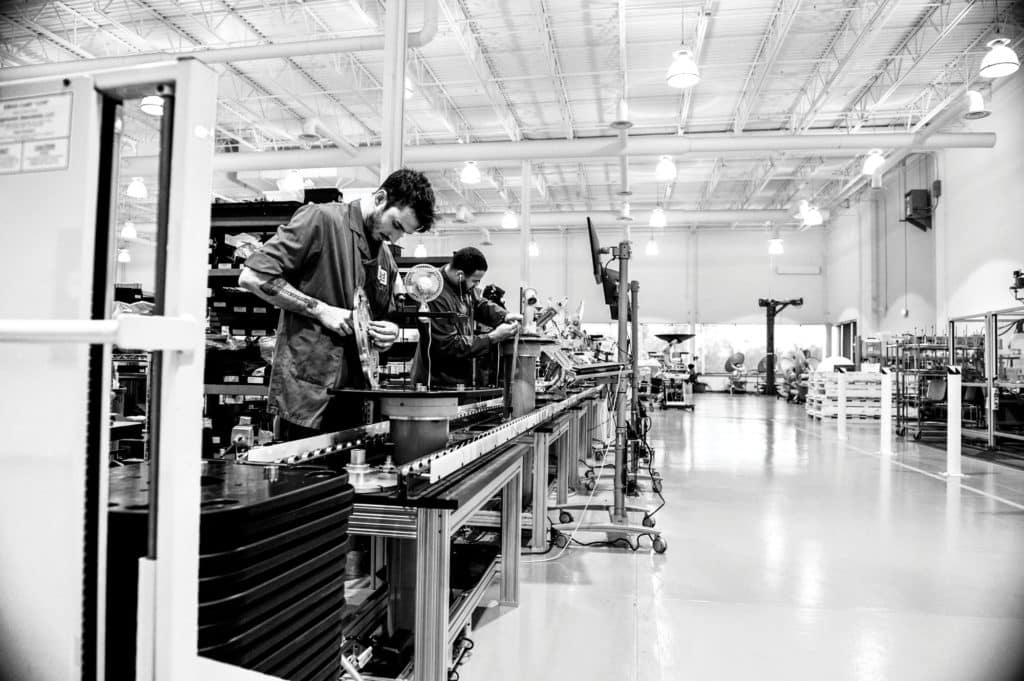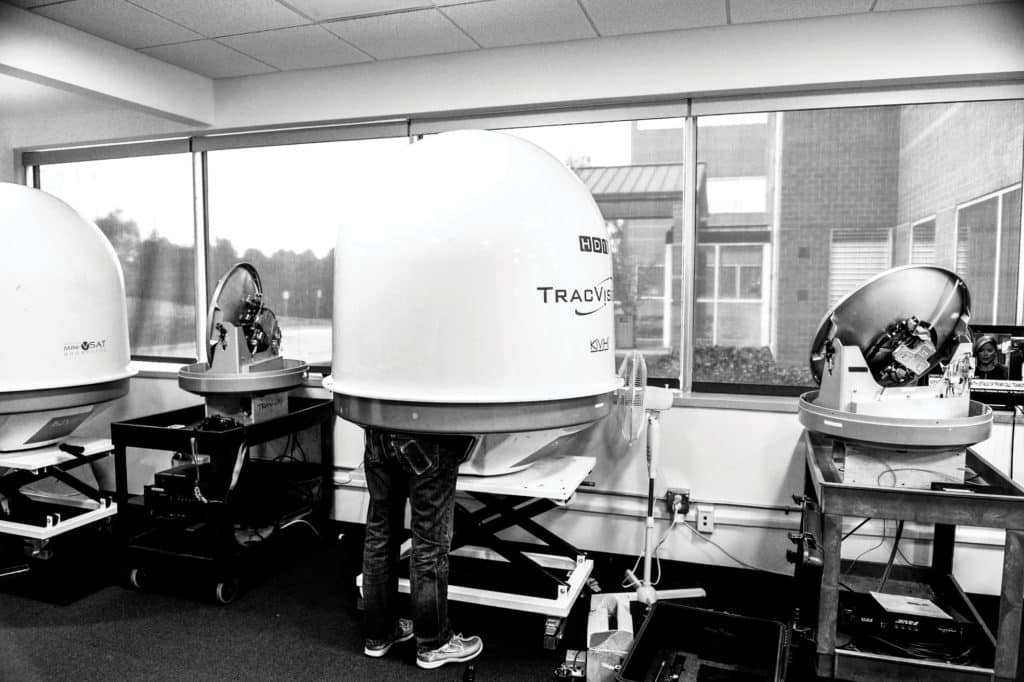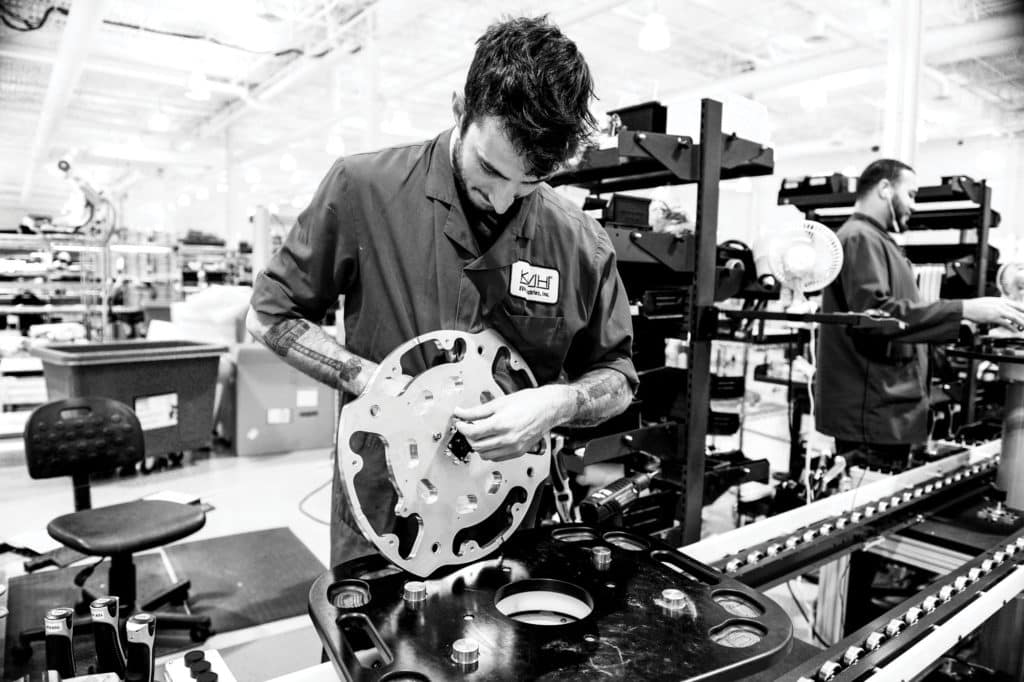
Click, click. Tick, tick. Click-tick. Click-tickity-tick. Clickity-tickity-click.
My ears struggle to decipher the unsyncopated cacophony ringing from a sequestered testing room at KVH’s Middletown, Rhode Island, headquarters. “Hang out in here too long and you’ll go nuts,” says Alan Sylvestre, KVH Industries’ director of manufacturing.
He’s only partly joking. The staccato sounds emanate from motors that keep KVH-built very-small-aperture terminals (VSAT) and TV receive-only (TVRO) antennas locked onto their correct satellites. Sylvestre points to the digital counters below each motor. Some read “just” 13 million cycles (and counting), while others have surpassed 40 million tests.
Studying the motor-testing area, which sounds like a highly caffeinated, typewriter-driven newsroom, I realize that KVH’s stringent quality-control protocols support the company’s goal of scaling up service-provider operations without swelling employee head counts or customer costs. The approach has served the company well since it was founded during the run-up to the 1980 America’s Cup, and it has given yachtsmen access to onboard technology that was a pipe dream just a few decades ago.
KVH was born when the French America’s Cup syndicate sailing the 12-Meter France 3 wanted a tactical sailing computer. A team member made a chance acquaintance with a young Martin Kits van Heyningen, who was working at a Newport, Rhode Island, boatyard in between semesters at Yale University. When he heard what the sailors wanted, he said that his father, Arent Kits van Heyningen, then an engineer at Raytheon and an accomplished sailor himself, “could make anything.”
The elder Kits van Heyningen built the world’s first sailing-specific computer, as promised, but soon realized that analog fluxgate compasses weren’t compatible with digital computers. So, he returned to his basement laboratory and built the world’s first self-calibrating digital fluxgate compass.
He and his sons, Martin and Robert, worked under the SailComp banner from 1982 to 1985 before changing the family-owned business’s name to KVH. The company’s military-facing arm, TACNAV, was founded in 1991, and in 1997, KVH acquired the assets of the Andrews Corp.’s Sensor Products group, a Chicago-based fiber-optics developer. This purchase allowed KVH to become involved in the inertial navigation and fiber-optic gyroscope trade, and the company soon had clients ranging from the US government to commercial and recreational boaters.

KVH introduced its first TVRO system in 1994 and went public in 1996. In 1998, KVH started reselling Inmarsat’s L-band (1 to 2 GHz) satellite-communications antennas and airtime service before deciding to enter the satellite-communications trade itself. In 2007, KVH created its regional Ku-band mini-VSAT Broadband satellite-communications network by leasing satellite transponder space on geosynchronous satellites, and began manufacturing a 60-centimeter stabilized VSAT antenna—dubbed the TracPhone V7—that exclusively operated on this end-to-end network. In 2011, KVH added the 37-centimeter TracPhone V3 to its VSAT lineup, followed by the 1.1-meter TracPhone V11 in 2012.
These antennas and terminals drew upon the company’s core compass technologies. Today, KVH specializes in building fiber-optic gyro equipment, and satellite-communications and entertainment solutions.
And the company continues to innovate. In 2017, KVH launched the next-generation mini-VSAT Broadband 2.0 network, delivering faster service at attractive prices and supporting high-throughput-satellite (HTS) airtime service and antennas. The antennas include the TracPhone V7-HTS (2017), TracPhone V3-HTS (2018) and TracPhone V11-HTS (2019). Additionally, KVH launched the TracPhone LTE-1 antenna, delivering the lowest-cost routing across cellular and Wi-Fi networks.
“You can manage a business by cutting costs or by delighting the customer,” says Elizabeth Jackson, KVH’s chief marketing officer. “We’re focused on delighting the customer and setting them up for success.”
The company’s HTS antennas come with dual channels. There’s a high-speed line that’s typically reserved for owners, their guests, and critical communications such as stock trading, and a second, slower (but free with unlimited data) line that’s meant for crew use and uploading data to the cloud.
“KVH’s Watch technology lets us [monitor] the performance of each antenna,” Jackson says, explaining that this internet-of-things portal is a key advantage to KVH’s end-to-end network. “We’ve grown so fast, it’s now a matter of having the systems to support the scaling. We used to be a hardware company. Now we’re a service company.”
Hardware is typically a one-time sale, while service represents an ongoing relationship and a business that can be scaled up without swelling head count.
“As we add more customers, we don’t need to add one-to-one employees to support the systems,” Jackson says. “There’s always some element of human [involvement], but infrastructure and systems can be scaled more efficiently.”
Additionally, KVH’s embedded data-use controls allow users to set their airtime allocations, which plays into customer demands for fast, dependable service and predictable bills.
“We collect position and performance data every three seconds,” says Robert Balog, KVH’s chief technology officer. The company uses this information to help customers avoid signal blockages.

And KVH can use vessel-generated data such as speed, heading, roll, pitch and yaw—as well as vibration levels—to see any effects on the yacht’s VSAT performance. Inside KVH’s network operations center, screens and maps show every KVH-equipped vessel, its operational status and its performance metrics.
“Our system monitors every region,” says Jeff St. Pierre, KVH’s senior manager of global technical support. “We want to notice any issues before the customers.”
KVH’s back-end analytics constantly check for latency issues, packet loss, thrashing (the time an antenna spends hunting for a satellite), speed and connectivity. Should any network issues arise, St. Pierre’s team is on hand 24/7/365.
Other specialist team members can be found on KVH’s cavernous production floor, where the company does final assembly of two-axis stabilized TVRO antennas and two- or three-axis stabilized VSAT terminals.
“Each line is its own product,” Sylvestre says, adding that factory workers are trained to build and pack specific products. “All tools are calibrated, and every screw has a torque requirement.”
KVH practices the process of lean manufacturing with a single-piece flow, inspired by Toyota. KVH designs components in-house but builds them elsewhere.
“When I started here 25 years ago, lead time was 16 weeks,” Sylvestre says with a smile. “Now it’s two days, or one if it’s the last day of the quarter.”
While skinny lead times are good for getting products to customers, Rick Driscoll, KVH’s vice president of service development and implementation, says that what yachtsmen really want is the ability to stream data. KVH offers speed-based plans, where customers buy gigabytes of data at the fastest speeds available, and fixed-price plans that deliver predictable bills at slower speeds. There’s also a high-end, high-speed, unlimited-data streaming service for V7-HTS and V11-HTS customers.
“The holy grail is full streaming on a yacht at a reasonable price,” says Jim George, KVH’s senior director of global leisure sales. “People want the same [streaming] experience on their boat that they have at home without worrying about overages.”









